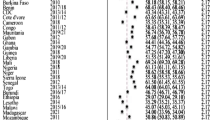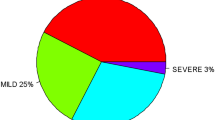Abstract
Background/Objectives:
Anemia is a significant public health concern, especially among women and young children. An improved understanding of the complex etiology of anemia is crucial for developing appropriate prevention strategies. This paper examines the determinants of anemia in a large sample of Vietnamese women of reproductive age (WRA).
Methods:
We included baseline data from 4986 WRA participating in a randomized controlled trial (PRECONCEPT). Hemoglobin (Hb) concentrations were measured with Hemocue. Plasma ferritin (Fe), retinol binding protein (RBP) and markers of inflammation were assessed using the ELISA technique. We used multivariate logistic regression to describe associations with anemia and structural equation modeling (SEM) to characterize direct and indirect pathways influencing Hb concentrations.
Results:
Prevalence of anemia, iron deficiency (Fe <12 μg/l), insufficient iron stores (Fe<30 μg/l) and iron deficiency anemia was 19.7, 3.5, 14.4 and 1.9%, respectively. Ferritin concentration (0.29 per log-mg/dl), being an ethnic minority (−0.24 compared with Kinh), number of children (−0.17) and socioeconomic status (0.09) were directly associated with Hb concentration (P<0.05). Similarly, RBP was directly (0.27 per mg/dl) associated with Hb and also indirectly (0.09 mg/dl) with ferritin. Hookworm infection was indirectly associated with Hb (−0.11) through RBP and ferritin.
Conclusion:
These findings illustrate the complex etiology of anemia and provide a useful framework for designing, targeting and evaluating appropriate strategies for the prevention and control of anemia. Contrary to expectations, iron deficiency accounted for a very small proportion of anemia in Northern Vietnam.
This is a preview of subscription content, access via your institution
Access options
Subscribe to this journal
Receive 12 print issues and online access
$259.00 per year
only $21.58 per issue
Buy this article
- Purchase on Springer Link
- Instant access to full article PDF
Prices may be subject to local taxes which are calculated during checkout

Similar content being viewed by others
References
Benoist BD, McLean E, Egli I, Cogswell M . Worldwide prevalence of anaemia 1993–2005. In: WHO Global Database on Anemia, 2008.
NIN Survey on Anemia and Sub-Clinical Vitamin A Deficiency. http://viendinhduong.vn/FileUpload/Documents/Bang4,5%20TL%20thieu%20VA,%20Iod-THDD%202009-2010.PDF2008.
Iron Deficiency Anemia. Assessment, Prevention, Control. WHO: United Nations Children's Fund, United Nations University (ed.), World Health Organization: Geneva, Switzerland, 2001.
Stoltzfus RJ . Iron interventions for women and children in low-income countries. J Nutr 2011; 141: 756S–762S.
Tolentino K, Friedman JF . An update on anemia in less developed countries. Am J Trop Med Hyg 2007; 77: 44–51.
Dreyfuss ML, Stoltzfus RJ, Shrestha JB, Pradhan EK, LeClerq SC, Khatry SK et al. Hookworms, malaria and vitamin A deficiency contribute to anemia and iron deficiency among pregnant women in the plains of Nepal. J Nutr 2000; 130: 2527–2536.
Sharma S, Sheehy T, Kolonel LN . Contribution of meat to vitamin B(12), iron and zinc intakes in five ethnic groups in the USA: implications for developing food-based dietary guidelines. J Hum Nutr Diet 2013; 26: 156–168.
Jinabhai CC, Taylor M, Coutsoudis A, Coovadia HM, Tomkins AM, Sullivan KR . A randomized controlled trial of the effect of antihelminthic treatment and micronutrient fortification on health status and school performance of rural primary school children. Ann Trop Paediatr 2001; 21: 319–333.
Ramakrishnan U, Semba RD . Iron deficiency anemia. In: Nutrition and Health in Developing Countries2nd edn Semba RD (ed.), Humana Press: USA, 479–505 2008.
Balarajan Y, Ramakrishnan U, Ozaltin E, Shankar AH, Subramanian SV . Anaemia in low-income and middle-income countries. Lancet 2011; 378: 2123–2135.
Cotta RM, Oliveira Fde C, Magalhaes KA, Ribeiro AQ, Sant'Ana LF, Priore SE et al. Social and biological determinants of iron deficiency anemia. Cad Saude Publica 2011; 27 (Suppl 2), S309–S320.
Scrimshaw NS . Functional consequences of iron deficiency in human populations. J Nutr Sci Vitaminol (Tokyo) 1984; 30: 47–63.
Ferdous J, Ahmed A, Dasgupta SK, Jahan M, Huda FA, Ronsmans C et al. Occurrence and determinants of postpartum maternal morbidities and disabilities among women in Matlab, Bangladesh. J Health Popul Nutr 2012; 30: 143–158.
Kumar KJ, Asha N, Murthy DS, Sujatha M, Manjunath V . Maternal anemia in various trimesters and its effect on newborn weight and maturity: an observational study. Int J Prev Med 2013; 4: 193–199.
Rasmussen K . Is there a causal relationship between iron deficiency or iron-deficiency anemia and weight at birth, length of gestation and perinatal mortality? J Nutr 2001; 131: 590S–601S. discussion 601S-603S.
Scholl TO, Reilly T . Anemia, iron and pregnancy outcome. J Nutr 2000; 130: 443S–447S.
WHO. Global Health Risks: Mortality and Burden of Disease Attributable to Selected Major Risks. World Health Organization: Geneva, Switzerland, 2009.
Institute of Medicine. Iron Deficiency Anemia: Recommended Guidelines for the Prevention, Detection, and Management Among U.S. Children and Women of Childbearing Age. National Academy Press: Washington, DC, 1993.
Ramakrishnan U, Grant F, Goldenberg T, Zongrone A, Martorell R . Effect of women's nutrition before and during early pregnancy on maternal and infant outcomes: a systematic review. Paediatr Perinat Epidemiol 2012; 26: 285–301.
Nguyen PH, Lowe AE, Martorell R, Nguyen H, Pham H, Nguyen S et al. Rationale, design, methodology and sample characteristics for the Vietnam pre-conceptual micronutrient supplementation trial (PRECONCEPT): a randomized controlled study. BMC Public Health 2012; 12: 898.
UNICEF. The State of the World’s Children. http://www.unicef.org/sowc98/pdf.htm. Oxford University Press: New York, NY, 1998.
Hemocue Hemocue Hb301, http://www.hemocue.com/international/Products/Hemoglobin-1155.html. 2012.
Erhardt JG, Estes JE, Pfeiffer CM, Biesalski HK, Craft NE . Combined measurement of ferritin, soluble transferrin receptor, retinol binding protein, and C-reactive protein by an inexpensive, sensitive, and simple sandwich enzyme-linked immunosorbent assay technique. J Nutr 2004; 134: 3127–3132.
Tran DT . FFQ for adult in rural Vietnam. In: An Examination of the Relationship Between Low Body Mass Index and Micronutrient Malnutrition and the Risk of Morbidity in Adults Aged 18 to 60 in Rural Vietnam. PhD thesis, The University of Newcastle: Australia, 2009.
NIN, MOH. Vietnamese Food Composition Table. Medical Publishing Housing: Hanoi, 2007.
WHO. Basic Laboratory Methods in Medical Parasitology. Geneva: World Health Organization, 1991.
Vyas S, Kumaranayake L . Constructing socio-economic status indices: how to use principal components analysis. Health Policy Plan 2006; 21: 459–468.
Gwatkin D, Rutstein S, Johnson K, Suliman E, Wagstaff A, Amouzou A . Socio-economic differences in health, nutrition, and population within developing countries: an overview. Niger J Clin Pract 2007; 10: 272–282.
Coates J, Swindale A, Bilinsky P Household Food Insecurity Access Scale (HFIAS) for Measurement of Household Food Access: Indicator Guide (v. 3). Food and Nutrition Technical Assistance Project, Academy for Educational Development: Washington, DC, 2007.
Cook JD, Skikne BS . Iron deficiency: definition and diagnosis. J Intern Med 1989; 226: 349–355.
Gibson R . Principles of Nutritional Assessment. 2nd edn. Oxford University Press: New York, 2005.
Cook JD, Flowers CH, Skikne BS . The quantitative assessment of body iron. Blood 2003; 101: 3359–3364.
Thurnham DI, McCabe LD, Haldar S, Wieringa FT, Northrop-Clewes CA, McCabe GP . Adjusting plasma ferritin concentrations to remove the effects of subclinical inflammation in the assessment of iron deficiency: a meta-analysis. Am J Clin Nutr 2010; 92: 546–555.
Pearson TA, Mensah GA, Alexander RW, Anderson JL, Cannon RO 3rd, Criqui M et al. Markers of inflammation and cardiovascular disease: application to clinical and public health practice: A statement for healthcare professionals from the Centers for Disease Control and Prevention and the American Heart Association. Circulation 2003; 107: 499–511.
Gasche C, Berstad A, Befrits R, Beglinger C, Dignass A, Erichsen K et al. Guidelines on the diagnosis and management of iron deficiency and anemia in inflammatory bowel diseases. Inflamm Bowel Dis 2007; 13: 1545–1553.
Bruzzi P, Green SB, Byar DP, Brinton LA, Schairer C . Estimating the population attributable risk for multiple risk factors using case-control data. Am J Epidemiol 1985; 122: 904–914.
SAS. SAS System Version 93 for Windows 64 bit. SAS Institute Inc.: Cary, NC, USA, 2010.
GSO: General Statistics Office Vietnamese Industry in 20 Years of Renovation and Development, General Statistics Office of Vietnam: Hanoi, 2005.
Laillou A, Pham TV, Tran NT, Le HT, Wieringa F, Rohner F et al. Micronutrient deficits are still public health issues among women and young children in Vietnam. PLoS ONE 2012; 7: e34906.
Nguyen PH, Nguyen KC, Le Mai B, Nguyen TV, Ha KH, Bern C et al. Risk factors for anemia in Vietnam. Southeast Asian J Trop Med Public Health 2006; 37: 1213–1223.
Pasricha SR, Caruana SR, Phuc TQ, Casey GJ, Jolley D, Kingsland S et al. Anemia, iron deficiency, meat consumption, and hookworm infection in women of reproductive age in northwest Vietnam. Am J Trop Med Hyg 2008; 78: 375–381.
Bloem MW . Interdependence of vitamin A and iron: an important association for programmes of anaemia control. Proc Nutr Soc 1995; 54: 501–508.
West KP Jr . Extent of vitamin A deficiency among preschool children and women of reproductive age. J Nutr 2002; 132: 2857S–2866S.
Zimmermann MB, Biebinger R, Rohner F, Dib A, Zeder C, Hurrell RF et al. Vitamin A supplementation in children with poor vitamin A and iron status increases erythropoietin and hemoglobin concentrations without changing total body iron. Am J Clin Nutr 2006; 84: 580–586.
Leenstra T, Kariuki SK, Kurtis JD, Oloo AJ, Kager PA, ter Kuile FO . The effect of weekly iron and vitamin A supplementation on hemoglobin levels and iron status in adolescent schoolgirls in western Kenya. Eur J Clin Nutr 2009; 63: 173–182.
Oliveira JM, Michelazzo FB, Stefanello J, Rondo PH . Influence of iron on vitamin A nutritional status. Nutr Rev 2008; 66: 141–147.
Van Thuy P, Berger J, Nakanishi Y, Khan NC, Lynch S, Dixon P . The use of NaFeEDTA-fortified fish sauce is an effective tool for controlling iron deficiency in women of childbearing age in rural Vietnam. J Nutr 2005; 135: 2596–2601.
Thuy PV, Berger J, Davidsson L, Khan NC, Lam NT, Cook JD et al. Regular consumption of NaFeEDTA-fortified fish sauce improves iron status and reduces the prevalence of anemia in anemic Vietnamese women. Am J Clin Nutr 2003; 78: 284–290.
Casey GJ, Montresor A, Cavalli-Sforza LT, Thu H, Phu LB, Tinh TT et al. Elimination of iron deficiency anemia and soil transmitted helminth infection: evidence from a fifty-four month iron-folic acid and de-worming program. PLoS Negl Trop Dis 2013; 7: e2146.
Svasti S, Hieu TM, Munkongdee T, Winichagoon P, Van Be T, Van Binh T et al. Molecular analysis of beta-thalassemia in South Vietnam. Am J Hematol 2002; 71: 85–88.
Nguyen CK . The frequency of hemoglobinopathies in Vietnam. Vietnam J Med 1993; 8: 11–16.
Morris SS, Ruel MT, Cohen RJ, Dewey KG, de la Briere B, Hassan MN . Precision, accuracy, and reliability of hemoglobin assessment with use of capillary blood. Am J Clin Nutr 1999; 69: 1243–1248.
Knopp S, Speich B, Hattendorf J, Rinaldi L, Mohammed KA, Khamis IS et al. Diagnostic accuracy of Kato-Katz and FLOTAC for assessing anthelmintic drug efficacy. PLoS Negl Trop Dis 2011; 5: e1036.
Booth M, Vounatsou P, N'Goran E K, Tanner M, Utzinger J . The influence of sampling effort and the performance of the Kato-Katz technique in diagnosing Schistosoma mansoni and hookworm co-infections in rural Cote d'Ivoire. Parasitology 2003; 127: 525–531.
Acknowledgements
Funding for this research was provided by the Mathile Institute for the Advancement of Human Nutrition and the Micronutrient Initiative.
Author information
Authors and Affiliations
Corresponding author
Ethics declarations
Competing interests
The authors declare no conflict of interest.
Rights and permissions
About this article
Cite this article
Nguyen, P., Gonzalez-Casanova, I., Nguyen, H. et al. Multicausal etiology of anemia among women of reproductive age in Vietnam. Eur J Clin Nutr 69, 107–113 (2015). https://doi.org/10.1038/ejcn.2014.181
Received:
Revised:
Accepted:
Published:
Issue Date:
DOI: https://doi.org/10.1038/ejcn.2014.181
This article is cited by
-
Etiology of Mild and Moderate Anaemia Among Rural Adolescent Girls in India
Indian Journal of Hematology and Blood Transfusion (2023)
-
The association between socioeconomic disparities and left ventricular hypertrophy in chronic kidney disease: results from the KoreaN Cohort Study for Outcomes in Patients With Chronic Kidney Disease (KNOW-CKD)
BMC Nephrology (2018)
-
Dietary intake patterns and nutritional status of women of reproductive age in Nepal: findings from a health survey
Archives of Public Health (2016)



